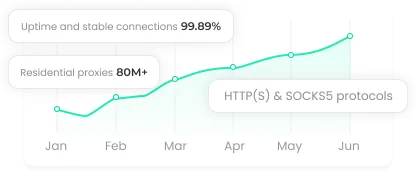How to Handle IP Bans and Stay Online
Ever tried accessing a website only to hit a brick wall? You type the URL, press enter—and nothing. No error, no explanation. Just… blocked. That’s the reality of an IP ban. Websites use it to lock out specific users, protect resources, or enforce rules. And it can stop you in your tracks, whether you’re browsing, working, or collecting data for legitimate purposes. But being blocked isn’t the end. You can regain access—and do it safely. Let’s break down why IP bans happen and how you can outsmart them without risking trouble.

Why IP Bans Happen
IP bans aren't random—they're purposeful. Websites implement them to keep their platforms safe and running smoothly. Here's what usually triggers a ban:
1. Overloading Requests
If your IP floods a website with hundreds of requests in minutes, the system flags it as automated. Bots, scrapers, and even some aggressive browsing patterns can trigger this. The goal? Prevent server overload and protect the site's resources.
2. Policy Violations
Breaking a website's rules—spamming, manipulating features, or triggering errors intentionally—can land your IP on the blacklist. Sites want to protect legitimate users and maintain trust.
3. Geographical Restrictions
Some bans are location-based. Streaming services, marketplaces, and content platforms often block IPs from certain countries to comply with licensing laws or regional policies. Even if your behavior is flawless, geography alone can lock you out.
How to Prevent Being Banned
Understanding the cause is half the battle. Here's how to reduce the risk of being blocked:
1. Control Access Frequency
Don't hammer the server. Spread out requests, simulate human behavior, and avoid repetitive patterns. A few seconds here and there makes a huge difference.
2. Utilize Multiple IP Addresses
Rotating IPs prevents a single address from being flagged. This is especially important if you scrape data, run tests, or access high-traffic services frequently.
3. Mimic Human Interaction
Websites detect bots through behavior patterns. Move your mouse, vary clicks, and mix timings. Natural patterns are much less suspicious.
4. Leverage Residential Proxies
Residential proxies can rotate IPs. They hide your real address, bypass geographical and policy restrictions, and reduce the chance of being detected or banned.
How to Bypass an IP Ban
Even if you're already blocked, there are practical ways back in:
1. Proxy Servers
Proxies sit between you and the website, masking your IP. Options include:
HTTP/HTTPS Proxies: Simple, browser-based solutions.
SOCKS Proxies: Handle multiple types of traffic, more versatile.
Reliable providers are essential. Cheap proxies can leak data or drop connections.
2. Switch Your IP Address
You can reset your router or reconnect to your ISP to get a new IP. It works sometimes—but the ban might reappear, so this isn't foolproof.
3. Dynamic IPs
Using a dynamic IP setup automatically rotates your address, allowing you to regain access without manual resets. Some ISPs provide this, or you can use dynamic IP software.
Conclusion
IP bans are a common hurdle, but they do not have to stop you. By understanding why bans occur and using strategies such as controlling request frequency, rotating IPs, mimicking human behavior, and leveraging residential proxies, you can access websites safely and reliably.
With the right approach, data collection, testing, and everyday browsing can continue uninterrupted, keeping your operations efficient, secure, and compliant.





















































